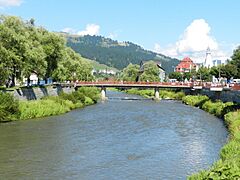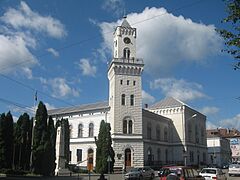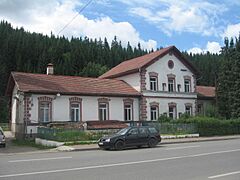Vatra Dornei facts for kids
Quick facts for kids
Vatra Dornei
|
||
|---|---|---|
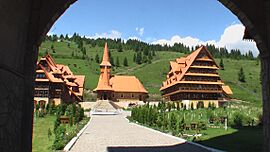
Traditional Romanian wooden church in Dorna-Arini (2012)
|
||
|
||
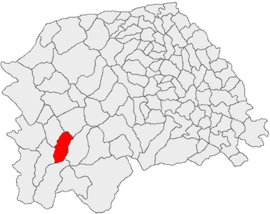
Location in Suceava County
|
||
| Country | ||
| County | Suceava | |
| Area | 144.34 km2 (55.73 sq mi) | |
| Elevation | 802 m (2,631 ft) | |
| Population
(2011)
|
Lua error in Module:Wd at line 1,575: attempt to index field 'wikibase' (a nil value). | |
| Time zone | EET/EEST (UTC+2/+3) | |
| Postal code |
725700
|
|
| Area code | (+40) 0230 | |
Vatra Dornei (Romanian pronunciation: [ˌvatra ˈdornej]; German: Dorna Watra or Dorna-Watra; Hungarian: Dornavátra; Yiddish: דאָרנע, romanized: Dorne) is a town in Suceava County, north-eastern Romania. It is situated in the historical region of Bukovina. Vatra Dornei is the fifth largest urban settlement in the county, with a population of 12,578 inhabitants, according to the 2021 census.
It was declared a municipality in 2000, being the newest and smallest municipality in the county. The city administers three villages: Argestru, Roșu, and Todireni. Vatra Dornei is a well known spa and ski resort in the Carpathian Mountains and also is home to the historic Vatra Dornei Casino.
Geography
Vatra Dornei is located in north-east Romania, in the south-western part of Suceava County, 110 km (68 mi) away from Suceava, the capital of the county. The city of Câmpulung Moldovenesc is 40 km (25 mi) away, the city of Bistrița 85 km (53 mi) away, the town of Gura Humorului 74 km (46 mi) away and the town of Broșteni 52 km (32 mi) away.
Vatra Dornei is at the confluence of the rivers Bistrița and Dorna, in the Dorna Depression. Because of its mountain surroundings, the city is a spa and ski resort, one of the oldest resorts in Romania. Vatra Dornei is connected to the Romanian national railway system and has two railway stations, Vatra Dornei and Vatra Dornei Băi, both historical monuments. The European route E58, that links the region of Moldavia with Transylvania, crosses the city.
History
The earliest written mention of the settlement is from 1592. Together with the rest of Bukovina, Vatra Dornei was under the rule of the Habsburg monarchy (later Austria-Hungary) from 1775 to 1918. This was a period of development for the town, which became a well known resort in the early 19th century. Between 1925 and 1950, Vatra Dornei was part of the former Câmpulung County. From 1950 to present it's part of Suceava County.
The historic Vatra Dornei Casino is located in the municipality.
Demographics
| Historical population | ||
|---|---|---|
| Year | Pop. | ±% |
| 1930 | 9,826 | — |
| 1948 | 7,078 | −28.0% |
| 1956 | 10,822 | +52.9% |
| 1966 | 13,815 | +27.7% |
| 1977 | 15,873 | +14.9% |
| 1992 | 18,488 | +16.5% |
| 2002 | 16,321 | −11.7% |
| 2011 | 14,429 | −11.6% |
| 2021 | 12,578 | −12.8% |
| Source: Romanian census data and/or official estimates | ||
Until the early 1950s, Vatra Dornei had an ethnically mixed population of Romanians, Germans (more specifically Bukovina Germans), Ukrainians, and Jews. The large synagogue and a picturesque Jewish cemetery bear witness to the Jewish presence and historical legacy in the area.
Vatra Dornei reached its peak population in 1992, when about 18,500 people were living within the town limits. Then the city population declined gradually. According to the 2011 census, Vatra Dornei had a total population of 13,659 inhabitants. Of this population, 98.65% are ethnically Romanians, 0.64% Roma, 0.23% Germans (Bukovina Germans), 0.22% Hungarians, and 0.10% Ukrainians.
Vatra Dornei is the fifth most populated urban settlement in Suceava County, after the county capital, Suceava, and the cities of Rădăuți, Fălticeni, and Câmpulung Moldovenesc. Vatra Dornei is also the smallest and newest municipality in Suceava County.
Tourism
Vatra Dornei is a well known ski resort in the Carpathian Mountains. There are ski slopes nearby the city, attracting tourists in winter season. Vatra Dornei is surrounded by large forest areas, proper places for practicing alpine tourism. There are mineral water springs in the city limits and its surroundings, that helped the settlement to develop as a spa. In the late 19th century and early 20th century Bukovina had only two spa towns: Vatra Dornei and Solca.
Vatra Dornei has several hotels, two museums (The Ethnographic Museum and The Museum of Natural Sciences) and a few old buildings that are considered historical and architectural monuments: the casino, the main spa building, the two railway stations, the town hall, Sentinela Spring, the post office building, and a few old churches.
Vatra Dornei is also part of the Via Transilvanica long-distance trail.
Natives
- Valentin Buhăcianu (born 1993), footballer
- Robert Candrea (born 1995), footballer
- Vasile Deac (1824–1909), Mayor of Vatra Dornei
- Liliana Ichim (born 1967), alpine skier
- Alfred Kuzmany (1893–1961), army general in the Wehrmacht in World War II
- Bogdan Macovei (born 1983), luger
- Andrei Nilă (born 1985), footballer
- Platon Pardău (1934–2002), poet and writer
- Teodosie Petrescu (born 1955), cleric
Gallery
See also
 In Spanish: Vatra Dornei para niños
In Spanish: Vatra Dornei para niños




